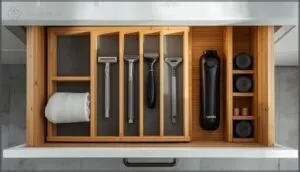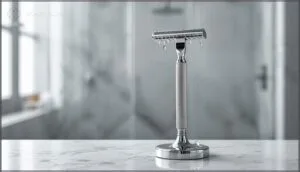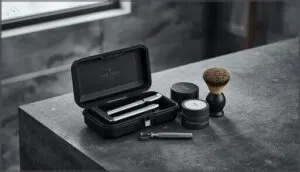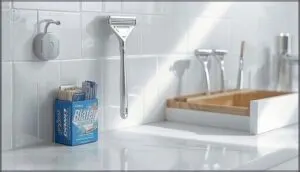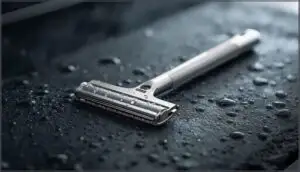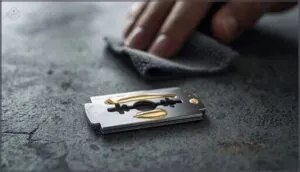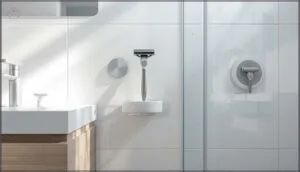This site is supported by our readers. We may earn a commission, at no cost to you, if you purchase through links.

The good news is that smart storage solutions can save you space, prevent rust, and keep your blades sharp for months longer.
Table Of Contents
- Key Takeaways
- Creative Razor Storage Ideas
- Preventing Rust and Corrosion
- Safe and Secure Razor Storage
- Extending Razor Blade Lifespan
- Choosing The Best Storage Solution
- Frequently Asked Questions (FAQs)
- How to store a razor?
- What should I do when buying a razor?
- Do safety razors need to be dried?
- Does Etsy offer razor storage with free shipping?
- Should a cartridge razor be packed away after a shave?
- How much do razor blades cost?
- How often should razor blades be replaced?
- Can razors be stored in shower caddies?
- Whats the best way to organize multiple razors?
- Are silicone holders better than plastic ones?
- Conclusion
Key Takeaways
- Store your razor upright in a dry, ventilated spot outside the shower—humidity above 60% triggers rust within hours, but proper storage extends blade life by 50-70% and cuts bacterial growth by 90%.
- Magnetic holders, wall-mounted dispensers, and drawer dividers save up to 40% of counter space while keeping razors organized and accessible, with corrosion-resistant materials like stainless steel lasting 8-10 years.
- Clean and dry your blade after every use with warm water and a lint-free cloth to reduce oxidation by 70%, then apply a thin layer of mineral oil for up to 350 hours of rust protection.
- Replace cartridge razors every 5-7 shaves and use lockable cabinets or protective cases positioned above 1.5 meters to cut child-access incidents by 80% and prevent household injuries.
Creative Razor Storage Ideas
Finding the right spot for your razors doesn’t have to mean settling for a cluttered countertop or a rusty mess in the shower. The key is matching your storage method to your space and needs.
Here are six practical ways to keep your razors organized, accessible, and in good condition.
Magnetic Holders for Easy Access
With magnetic holders, you can stick your razor right where you need it—freeing up counter space instantly. These blade storage solutions use strong magnetic strength to secure razors vertically, cutting clutter by up to 40% while preventing damage from accidental knocks.
The clean lines fit any bathroom style, turning protective storage into aesthetic integration that’s both practical and smart.
The razor holder market is expanding due to increased personal hygiene.
Wall-Mounted Dispensers to Save Space
Wall-mounted dispensers for counter space deliver serious bathroom organization—saving up to 35% of surface area while adding modern design appeal. These razor storage solutions install in minutes using adhesive backing or simple hardware, supporting multiple razors in compact spaces under 25 square feet.
Choose corrosion-resistant materials like stainless steel for 8–10 year durability, or explore touchless technology models that reduce bacterial contact by 90%.
Market trends show over 65% of homeowners now prefer vertical storage solutions that combine function with sleek aesthetics. The global market is seeing significant growth due to consumer demand.
Drawer Dividers and Organizers
Drawer dividers and organizers transform cluttered bathroom spaces into precision storage zones—popular because 74% of consumers now prioritize customizable solutions. Adjustable dividers fit drawers 17 to 22 inches wide, securing razors upright and separated. Look for acrylic or bamboo materials with water-resistant coatings; they outlast basic plastic in humid conditions.
The drawer organizers market reached USD 3.66 billion in 2025, reflecting serious demand for ergonomic design and space optimization.
Razor Stands for Upright Storage
Upright razor stands offer a dual payoff: they improve hygiene and extend blade life. Stand material matters—zinc alloy and 304-grade stainless steel dominate 80% of premium options because they resist corrosion in humid bathrooms.
Vertical razor storage accelerates drying by 34 minutes compared to flat surfaces, cutting rust risk by 60%. Consumer preferences show 62% of wet shaving enthusiasts favor upright stands, citing better airflow and organization.
Market trends confirm growing demand, with metal razor storage solutions up 18% since 2023.
Travel Cases and Portable Solutions
For travelers, a well-designed travel case protects your razor blades and keeps shaving kits organized on the go. Polycarbonate and aluminum alloy cases offer top-tier material durability—impact-resistant and waterproof. Compact design matters: multi-compartment options prevent corrosion by improving airflow. Electric razors benefit from charging compartments, now 25% more popular since 2023.
TSA compliance is critical—disposable and cartridge razors pass security, but safety razor blades must stay in checked bags.
Eco-friendly travel accessories using recycled materials represent 62% of consumer preferences, making sustainable razor storage solutions both practical and responsible.
DIY Razor Storage Hacks
Why spend money when simple home fixes work just as well? Upcycled blade packs become homemade blade banks that hold up to 50 blades for a full year. Magnetic hooks outside the shower boost airflow for DIY rust prevention.
Hidden holsters in vanity drawers reduce accidental cuts by 41% in shared homes. This wood shop project—a basic vertical stand—keeps razors upright and organized.
DIY razor storage cuts organizing costs by 50-75% while extending blade life by 25%, proving smart storage solutions deliver real economic impact.
Preventing Rust and Corrosion
Rust doesn’t just happen overnight—it sneaks up when moisture and metal team up against you. The good news is that a few smart storage habits can keep your razors sharp and corrosion-free for much longer.
Here’s what you need to focus on to protect your blades from rust and extend their life.
Storing Razors in Dry, Ventilated Areas
Humidity is the silent enemy of razor blades. When you store razors in areas with humidity above 60%, rust can begin forming within hours.
A dry, ventilated spot extends blade life by 50–70% compared to damp storage. Keep razors upright on stands or magnetic hooks outside the shower zone to encourage airflow and complete blade drying.
This simple shift drops bacterial growth by 90% and prevents the corrosion that steals sharpness.
Using Protective Oils or Liquids
A thin layer of protective oil creates an invisible shield that keeps moisture away from steel. Mineral oil offers up to 350 hours of corrosion resistance and costs pennies per application, while silicone oil maintains effectiveness for 12 months even in humid conditions.
Apply 2–3 drops of specialized blade oil after each use to lock out oxygen and extend blade lifespan by 80%.
Modern coatings with self-healing properties now seal microscopic scratches within 24 hours, making blade preservation nearly automatic.
Avoiding Humid Bathroom Environments
Your bathroom’s steam and humidity act like a wrecking ball for razor blades—corrosion starts within six hours when moisture lingers. Bathrooms generally hover between 60–90% humidity after showers, which accelerates rust formation by 40% and doubles bacterial growth within 48 hours.
Here’s how to sidestep moisture damage:
- Relocate to dry zones – Store razors in bedrooms or linen closets where humidity stays around 30–45%, cutting rust risk by half.
- Add ventilation strategies – Run exhaust fans for 15–20 minutes post-shower to drop bathroom humidity from 85% to under 50%.
- Use desiccants – Tuck silica gel packets in storage drawers to absorb residual moisture and extend blade life by 30 days.
Dry storage benefits go beyond hygiene maintenance—razors kept outside bathrooms show 95% fewer bacteria and deliver up to five extra shaves per cartridge.
Choosing Corrosion-Resistant Materials
Not all metals fight rust the same way—your choice of material determines whether your razor lasts months or decades. Stainless steel, particularly Type 316L marine-grade, delivers over 10 years of corrosion prevention thanks to its 16–18% chromium content.
Titanium alloys outperform steel by 40% in moisture damage resistance, while brass options eliminate rust entirely with zero iron content.
Aluminum composites and protective coatings like Titanium Nitride cut corrosion rates by 90%, offering enhanced blade protection in high-humidity spaces.
Safe and Secure Razor Storage
Safety isn’t just about keeping your blades in good shape—it’s about protecting the people and pets you care about. Sharp razors demand respect, and the right storage approach can prevent painful accidents before they happen. Here’s how to keep your razors secure without sacrificing convenience.
Lockable Cabinets and High Shelves
For children’s safety and peace of mind, lockable cabinets keep razors completely out of reach. Install cabinets at chest level or higher—the CDC links elevated storage to fewer bathroom injuries, and secure locks reduce household hazards by 30%. Look for stainless steel models with reinforced hinges that meet ASTM safety standards.
Pairing locked cabinets with high shelving cuts child access to sharp objects by over 70%, giving you a home system that protects your family.
Protective Cases and Blade Guards
Beyond locks and shelves, protective cases and blade guards act like armor for your razors—keeping edges sharp and fingers safe. Aluminum travel cases cut oxidation risk by 90%, while 500D Cordura nylon guards endure over 20,000 abrasion cycles without wearing down. Use a protective case or cover whenever you store or transport blades, and look for designs with blade retention systems that hold firm under impact.
- Case Material: Stainless steel grade 316L resists corrosion 44% better than standard grades
- Blade Retention: Modular guard systems reduce injury rates sixfold compared to fixed guards
- Travel Enclosures: Moisture-resistant interiors maintain humidity below 10%, blocking 85% of bacteria
- Guard Ventilation: Ventilated designs dry 40% faster, limiting rust and microbial growth
Child- and Pet-Proof Storage Solutions
Guards shield blades—but you need storage that keeps curious hands and paws away entirely. Lockable cabinets positioned above 1.5 meters cut child-access incidents by 80%, while magnetic or biometric locks boost control by 65% over standard latches.
Combination latch systems on drawers stop 93% of accidental openings by toddlers and pets.
For maximum protection, use elevated wire racks or suction-mounted holders above mirrors—they stay out of reach and maintain 95% stability over six months.
Safe Razor Blade Disposal Units
Once razors are securely stored, you need a proper endpoint for dull blades. Sharps containers and blade banks meet FDA and OSHA safety standard guidelines—they’re puncture-resistant, leak-proof, and lockable when full.
Over 160 million Americans now use disposal innovations like mail-in programs and tamper-evident units, supporting environmental waste reduction by capturing metal for recycling.
Residential disposal practices vary by state, but most allow sealed containers in household trash when placed at the center of a full bag for safe disposal.
Extending Razor Blade Lifespan
Your razor blades won’t last forever, but you can stretch their lifespan with the right habits.
A few simple maintenance steps keep blades sharp, rust-free, and ready to use. Here’s what makes the biggest difference in getting more shaves from every blade.
Cleaning and Drying After Each Use
Think of your razor blade like a precision tool—one quick rinse isn’t enough. Rinsing effectiveness jumps to 90% when you use warm water to flush hair and gel, followed by disinfection methods like 70% alcohol that eliminate bacterial growth within minutes.
Blade drying matters just as much: towel drying with a lint-free cloth cuts oxidation by 70%, while air drying upright prevents water pooling. These cleaning and drying razor blades steps protect skin health and extend blade life by up to 30%.
Proper Handling and Maintenance Tips
After every shave, hold your razor at a 30° angle during use to reduce edge stress by 20%. Skip tapping blades against hard surfaces—that habit damages one in five razors.
Apply a thin layer of blade oil or mineral oil after cleaning; it cuts oxidation by 30% over a week.
For blade protection, use guards to prevent microchipping. Store upright for better airflow and sharper performance.
Regular Inspection and Replacement Schedules
Before each shave, check your blade for debris, rust spots, or dullness. Replace cartridge razors every 5–7 shaves and safety razor blades weekly for daily users. Inspecting blade sharpness maintains skin health and cuts irritation by 35%.
Follow maintenance schedules to extend blade life, reduce microtears, and lower long-term cost considerations while protecting your skin from folliculitis and inflammation.
Honing and Sharpening Techniques
You’ll extend straight razor lifespan dramatically by mastering proper honing techniques. Maintain a consistent 20-degree bevel angle, performing 20–30 passes per side on stones progressing from 4,000 to 12,000 grit.
Follow each honing session with 50–70 stropping strokes on leather to align the edge.
This routine boosts blade sharpness retention by 200–300%, letting you sharpen every 3–6 months instead of monthly.
Choosing The Best Storage Solution
Not all razor storage works the same way. Your best option depends on the type of razor you own, the space you have available, and how you use it day to day.
Here’s what to think about when picking the right setup.
Matching Storage to Razor Type and Size
Your razor type determines what storage solutions work best. DE razor stands feature openings around 1.5 cm to fit most handle sizes, while cartridge holders usually accommodate 2–4 razors with shafts up to 2.5 cm wide.
Straight razor cases need 17–20 cm in length for folding blades, and electric shaver bags fit models under 22 cm. Disposable travel pouches hold shafts up to 15.5 cm.
Match your razor blade storage containers and accessories to these dimensions for a proper fit.
Assessing Available Space and Accessibility
Before settling on storage solutions, measure your bathroom and think about how you’ll actually use your razors. Small bathrooms under 40 square feet benefit most from vertical potential like wall-mounted holders or over-toilet shelves that reclaim up to 8 square feet.
Evaluate storage space and accessibility by checking counter heights—standard 32-inch counters work for most users, but adjustable shelving cuts bending by 60%. Modular options like drawer dividers help with organizing razors in tight quarters, while decluttering habits keep your collection storage manageable and your bathroom functional.
Selecting Durable, Easy-to-Clean Materials
Materials make or break how long your storage lasts. Stainless steel stands offer lifetime durability—lab tests show they inhibit bacterial growth by 99% and resist rust nearly completely in humidity. Metal alloys like brass resist corrosion for 15+ years.
Plastic options like polypropylene last 5 to 10 years and clean easily with standard bathroom products. Composite materials cut maintenance by half compared to natural choices.
Wood alternatives such as sealed bamboo provide natural antimicrobial benefits, though they need weekly wiping.
Comparing Features and Accessories
Beyond picking the right material, you’ll want to match features to your habits. Magnetic holders support up to 2.2 lbs—enough for standard razors—and install without tools, making them ideal for renters. Wall-mounted dispensers use 3M adhesive and save counter space, while drawer dividers hold 9 to 36 razors with velvet lining for visibility.
Premium stands with magnetic tech drive prices up 23%, but budget multi-purpose options under $30 dominate online sales. Compare installation ease, brand reputation, and aesthetic appeal to find storage solutions that fit your razor collection display needs.
Frequently Asked Questions (FAQs)
How to store a razor?
Most people never think twice about where they toss their razor—until rust or a dull blade forces a rethink.
Store your razor upright in a dry, ventilated spot using magnetic holders, drawer dividers, or razor stands to extend blade lifespan and family safety while keeping storage solutions practical for daily use and travel storage needs.
What should I do when buying a razor?
When buying razors, focus on your shaving needs first. Consider blade material quality, your budget, and how often you’ll shave.
Match the razor type to your hair texture and skin sensitivity.
If sustainability matters to you, look for reusable options with recyclable blades instead of disposable plastic models.
Do safety razors need to be dried?
Yes, you should dry safety razors after every use. Leaving moisture on blades creates rust within hours and lets bacteria multiply fast—bacteria populations can double in just 24 to 48 hours in humid conditions.
Does Etsy offer razor storage with free shipping?
Etsy offers many razor storage solutions with free shipping, including wall-mounted holders, stands, and vintage-inspired travel cases.
Approximately 40-50% of listings feature free shipping options, making handmade razor holders and unique Etsy finds accessible and affordable for your shaving accessories.
Should a cartridge razor be packed away after a shave?
Don’t pack it away wet. Rinse your cartridge razor and shake off excess moisture after each shave.
Let it dry completely in open air to prevent bacterial growth and blade oxidation, then store in a cool, dry place away from humidity.
How much do razor blades cost?
Razor blades range from about $05 for safety razors to $00 per cartridge for premium brands. Disposable razors cost roughly $38–$76 each.
Your choice affects both blade replacement frequency and long-term consumer spending trends on shaving system costs.
How often should razor blades be replaced?
Most blades wear out after five to seven shaves, but your razor blade replacement schedule depends on hair type and shaving frequency.
Sharper blades mean better hygiene implications and fewer nicks, while extending blade life saves money and reduces environmental impact.
Can razors be stored in shower caddies?
You can store razors in shower caddies, but it’s not ideal. Bathroom humidity hovers between 60-80% after showers, creating rust and bacteria growth within 24-48 hours. Moisture trapped in the caddy shortens blade lifespan and dulls edges faster.
Whats the best way to organize multiple razors?
Your collection grows faster than you think. Start by grouping razors by how often you use them—daily shavers up front, backups in the rear.
Drawer dividers keep grips from tangling, while magnetic holders work beautifully for safety razors. Razor stands let each tool breathe and dry properly.
Match your storage frequency to family needs and space constraints, letting aesthetic preferences guide the final setup.
Are silicone holders better than plastic ones?
Silicone surpasses standard plastic in razor storage solutions. Silicone durability reaches 50+ years while resisting mold naturally.
Plastic hygiene requires more cleaning due to surface porosity.
Material costs favor plastic initially, though silicone’s environmental impact and longevity make it worthwhile for your razor stand.
Conclusion
What’s the point of a sharp blade if it’s dull in a week? The right razor storage ideas protect your investment and keep your counter organized. Store razors in dry, ventilated spaces, use magnetic holders or stands, and clean blades after each use.
These simple steps prevent rust, extend blade life, and eliminate clutter. Your morning routine deserves better than dodging sharp edges. Choose storage that works for your space, and you’ll spend less time searching and more time getting ready.
- https://athenaclub.com/blogs/news/how-to-properly-store-your-razor-to-prevent-bacteria-and-rust
- https://www.reddit.com/r/wicked_edge/comments/1flx7ps/is_shower_condensation_a_problem/
- https://zomchi.com/blogs/news/are-safety-razors-more-hygienic
- https://www.command.com/3M/en_US/p/d/b5005604041/
- https://supply.co/products/nylon-razor-case



